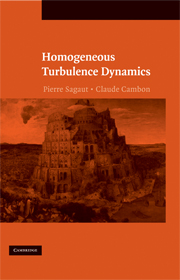Book contents
- Frontmatter
- Contents
- Abbreviations Used in This Book
- 1 Introduction
- 2 Statistical Analysis of Homogeneous Turbulent Flows: Reminders
- 3 Incompressible Homogeneous Isotropic Turbulence
- 4 Incompressible Homogeneous Anisotropic Turbulence: Pure Rotation
- 5 Incompressible Homogeneous Anisotropic Turbulence: Strain
- 6 Incompressible Homogeneous Anisotropic Turbulence: Pure Shear
- 7 Incompressible Homogeneous Anisotropic Turbulence: Buoyancy and Stable Stratification
- 8 Coupled Effects: Rotation, Stratification, Strain, and Shear
- 9 Compressible Homogeneous Isotropic Turbulence
- 10 Compressible Homogeneous Anisotropic Turbulence
- 11 Isotropic Turbulence–Shock Interaction
- 12 Linear Interaction Approximation for Shock–Perturbation Interaction
- 13 Linear Theories. From Rapid Distortion Theory to WKB Variants
- 14 Anisotropic Nonlinear Triadic Closures
- 15 Conclusions and Perspectives
- Bibliography
- Index
15 - Conclusions and Perspectives
- Frontmatter
- Contents
- Abbreviations Used in This Book
- 1 Introduction
- 2 Statistical Analysis of Homogeneous Turbulent Flows: Reminders
- 3 Incompressible Homogeneous Isotropic Turbulence
- 4 Incompressible Homogeneous Anisotropic Turbulence: Pure Rotation
- 5 Incompressible Homogeneous Anisotropic Turbulence: Strain
- 6 Incompressible Homogeneous Anisotropic Turbulence: Pure Shear
- 7 Incompressible Homogeneous Anisotropic Turbulence: Buoyancy and Stable Stratification
- 8 Coupled Effects: Rotation, Stratification, Strain, and Shear
- 9 Compressible Homogeneous Isotropic Turbulence
- 10 Compressible Homogeneous Anisotropic Turbulence
- 11 Isotropic Turbulence–Shock Interaction
- 12 Linear Interaction Approximation for Shock–Perturbation Interaction
- 13 Linear Theories. From Rapid Distortion Theory to WKB Variants
- 14 Anisotropic Nonlinear Triadic Closures
- 15 Conclusions and Perspectives
- Bibliography
- Index
Summary
Description and knowledge of turbulent flows is advancing well, particularly with the increasing development of numerical resources (Moore's law) and detailed measurements using more and more particle image velocimetry (PIV), stereoscopic particle image velocimetry (SPIV), and particle tracking velocimetry (PTV). Well-documented databases are created that can support techniques of data compression using a dramatically reduced number of modes (POD, wavelet coefficients, master modes, etc.).
Behind this attractive show window, however, the advance of our conceptual understanding of turbulent flows is much less satisfactory. Advances in numerics, experiments, data-compression schemes, are first beneficial to applied studies, for instance those using a smart combination of techniques (often referred to as multiphysics, with hybrid RANS–LES methods, and many others). Turbulent flows are well reproduced in the vicinity of a well-documented “design-point,” but this modeling is questioned far from it (“far” in the parameter's space, or simply in elapsed time for unsteady processes). Efficiency of data-compression schemes, for instance, is ellusive because a low-dimension set of modes, identified and validated near the design-point, can lose its relevance far from it.
We hope that this book will contribute to an honest and up-to-date survey of turbulence theory, with the special purpose of reconciling different angles of attack.
- Type
- Chapter
- Information
- Homogeneous Turbulence Dynamics , pp. 449 - 459Publisher: Cambridge University PressPrint publication year: 2008



